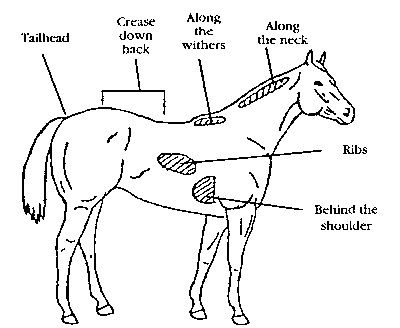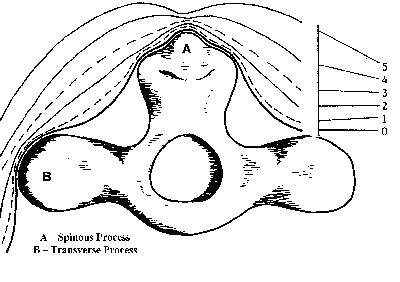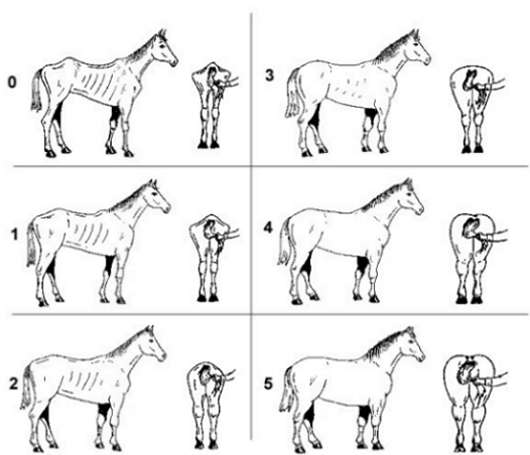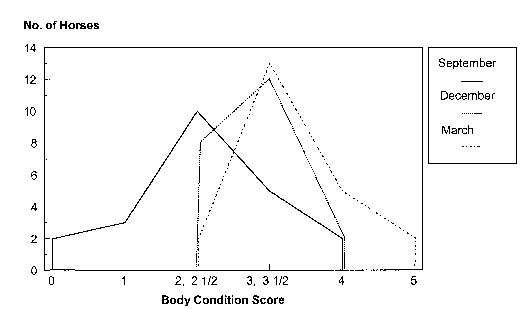Body condition scoring of horses
Learn how to apply body condition scoring to your horse.
ISSN 1198-712X, Published December 1998
Body Condition Scoring (BCS) is an objective system of evaluating a horse's level of body condition (amount of stored fat) and assessing a numeric score to facilitate comparisons between horses. Many owners fail to recognize significant variations in the weight of horses or variations due to age and breed types. This often results in overfeeding or underfeeding.
Body condition scoring involves the palpation and visual assessment of the degrees of fatness of various areas of the horse, such as: over the ribs, tailhead area, neck and withers, and behind the shoulders (Figure 1). Fat reserves in these areas depend on the balance between energy intake and energy loss, for various activities.

If there is a negative energy balance (energy loss greater than energy intake), then weight, and subsequent body condition, will be lost. This energy balance depends on such factors as: availability of food and water, weather (for example, ambient temperature and wind chill), reproductive activity (for example, pregnancy, lactation) and physical activity demands for growth and health status. A positive energy balance (energy expenditure less than energy intake) will result in a horse adding fat and muscle and improving body condition.
Body condition scoring
The body condition score system described here is mainly based on the system described by Carroll and Huntington (1988)(1). Palpation and visual inspection of the ribs, tailhead area, neck and withers, and behind the shoulders, facilitates the comparison of horses with differing amounts of stored body fat, independent of body size or breed of horse.
Figure 2 shows the profile lines for the various body condition scores. The profile of BCS 0 and 1 follow the anatomical skeleton and describe stages of emaciation and extremely thin respectively. A score of 3 has a smooth appearance to the skeletal structure and represents a horse in optimum body condition for maintenance and is neither gaining nor losing weight. Horses scoring 3+ to 4 have a rounded appearance to their skeletal structure. They are in above average flesh but this should not impair their reproductive ability, especially if they are being maintained in outdoor housing during the winter.
A long hair coat can be misleading. Some conformational differences make it difficult to apply certain criteria to a specific animal. For example, animals with prominent withers, or flat across the back and mares heavy in foal (weight of the foal pulls skin taut over the ribs) may cause body condition scores to be lower than they actually are. However, when properly applied, the scoring system is independent of size or conformation of the horse.


When evaluating animals, there will be an animal-to-animal variation; thus the use of the terms "easy-keeper" and "hard-keeper". Easy-keepers include any of the individuals of the draft breeds, ponies and quarter horses. They also include the dominant animals in a herd situation. Hard-keepers include many of the individuals of the following breeds: Arabian, thoroughbred and gaited horses. Hard-keepers will also include the shy individuals who are lower on the pecking order in a herd situation. Table 1 summarizes the various body condition scores, while Figure 3 depicts the changes in body appearance.
| Condition | Neck | Withers | Back & Loin | Ribs | Hind Quarters |
|---|---|---|---|---|---|
| 0 Very thin | bone structure easily felt- no muscle shelf where neck meets shoulder | bone structure easily felt | 3 points of vertebrae easily felt (see Figure 2) | each rib can be easily felt | tailhead and hip bones projecting |
| 1 Thin | can feel bone structure- slight shelf where neck meets shoulder | can feel bone structure | spinous process can be easily felttransverse processes have slight fat covering | slight fat covering, but can still be felt | can feel hip bones |
| 2 Fair | fat covering over bone structure | fat deposits over withers - dependent on conformation | fat over spinous processes | can't see ribs, but ribs can still be felt | hip bones covered with fat |
| 3 Good | neck flows smoothly into shoulder | neck rounds out withers | back is level | layer of fat over ribs | can't feel hip bones |
| 4 Fat | fat deposited along neck | fat padded around withers | positive crease along back | fat spongy over and between ribs | can't feel hip bones |
| 5 Very fat | bulging fat | bulging fat | deep positive crease | pockets of fat | pockets of fat |
| Score 0 | Emaciated |
|
|---|---|---|
| Score 1.0 | Poor |
|
| Score 2.0 | Moderate |
|
| Score 2.5 | - |
|
| Score 3.0 | Good |
|
| Score 3.5 | - |
|
| Score 4.0 | Fat |
|
| Score 5.0 | Very fat |
|
Herd evaluation with body condition scoring
The BCS system is often used when evaluating individual animals. However, when dealing with a group of horses, changes in the body condition from month to month as a result of changes in total feed being fed, or feed quality and utilization, can be evaluated. Follow the instructions and evaluate a group or herd of horses throughout a winter feeding period or throughout the year.
- Body condition score each horse in the herd. (The example uses a herd of 22 horses.) Record the results in a table like Table
- Create a blank chart similar to Figure 4, where Number of Horses is on the vertical-axis and BCS is recorded on the horizontal-axis. Place an "X" on the graph at the intersection of the number of horses in each group and the BCS.
- Join the markings, creating a line graph. Use a different colour for each month.
- Do this consecutively on a monthly basis. Observe any changes to the shape of the graph or movement of the curve either left or right.
| Body Condition Score | Number of Horses in Each Score | ||
|---|---|---|---|
| Number of horses in each score Sept. | Number of horses in each score Dec. | Number of horses in each score Mar. | |
| 0 | 2 | 0 | 0 |
| 1 | 3 | 0 | 0 |
| 2, 2 ½ | 10 | 8 | 2 |
| 3, 3 ½ | 5 | 12 | 13 |
| 4 | 2 | 2 | 5 |
| 5 | 0 | 0 | 2 |
Figure 4 shows the change in body condition for the herd of horses. Movement of the curve to the right shows that the herd is in a positive energy balance while movement to the left shows a negative energy balance.
The individuals who need extra care and energy are those whose body condition scores are 2 or less. These individuals usually include: older horses with poor teeth; young and shy horses that are competing for food; aged mares in foal; or mares that have been dragged down by lactation. Horses with a body condition score of 3.5 and above are usually the "easy-keepers", the dominant individuals, and ponies.
Nutrition was improved for the herd, especially those with body scores of less than 2. By the end of December, their body scores had improved and, by March, they were all greatly improved.

Summary
A consistent method of body condition scoring is a useful management tool. It will improve communication between stable employees, owners and veterinarians by providing a descriptive method, which is affected by changes in nutrition, physiological level of activity, or environmental conditions. It promotes a better awareness of feed utilization and allows for changes to feeding regimes based on individual and/or herd responses.
References
- Carroll C.L., and Huntington P. J., Body Condition Scoring and Weight Estimation of Horses, Equine Veterinary Journal (1988) 20 (1), 41 - 45.
- Henneke D. R., Potter G.D., Kreider J. L. and Yeates B. F., Relationship Between Condition Score, Physical Measurements and Body Fat Percentage in Mares, Equine Veterinary Journal (1983) 15 (4), 371 - 372.